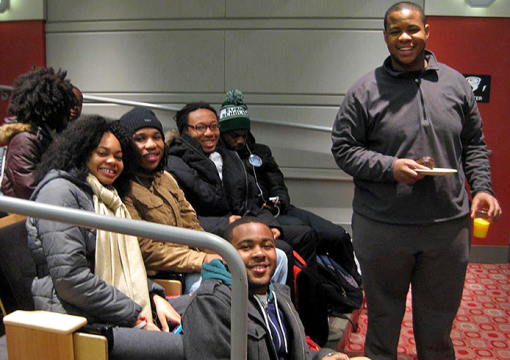
Students participate in a Buckeye Civic Engagement Connection program.
Photo courtesy of DaVonti’ Haynes
High-schoolers from Vinton County, Ohio, don’t have a grocery store or a hospital in their area.
There’s only one high school, and 60 percent of the 631 students there are considered economically disadvantaged, according to U.S. News and World Report.
But this year, some of those students will be able to see what a day as a college student is like in an attempt to give inner-city and Appalachian-area high school sophomores and juniors the opportunity to experience life at Ohio State.
The Buckeye Civic Engagement Connection’s program “A Day in the Life of a Buckeye” is set to host 165 students on March 25, said DaVonti’ Haynes, a “Day in the Life of a Buckeye” site leader.
BCEC works to connect Buckeyes with nearby communities, focusing on programming for people and communities facing poverty. Members are trained to work on poverty solutions that address health, education, design and economics in urban and rural communities, according to the program’s website.
Last year, students from three high schools attended “A Day in the Life of a Buckeye,” but this year’s event will include students from seven schools. Three schools are from the Cleveland Metropolitan School District, three are from Columbus City Schools, and the one is from Vinton County — Vinton County High School, about an hour and a half southeast of Columbus and located in an Appalachian county.
“A Day in the Life of a Buckeye,” which is in its third year, pairs an OSU student with a high-school student who shares interests in their major, job or student involvement. The OSU students take the high-school students around for the day through their normal schedules. OSU students apply to be considered as hosts, while high-schoolers only need to sign up.
“When we talk about gross levels of savage inequalities in schools and access to resources, how could you ever think about being an engineer in a place like Vinton County?” said Patty Cunningham, the director of BCEC. “They have no industry. You get matched with an electrical engineer and your whole life changes.”
Cunningham said the purpose of the program is to encourage the high-schoolers to pursue a college career.
“I think for some kids, they just need to be infused with hope,” she said.
Haynes, a third-year in public affairs, said the high-schoolers fill out surveys about how the experience has helped them after the program.
“The high-schoolers say they’re excited that someone was there to encourage them,” Haynes said. “Or they were able to see someone that had a similar background as them and went to Ohio State.”
The feedback shows that the high-schoolers walk away from the program with a sense of hope and motivation they didn’t have before, Haynes said. This might not get every student to go to OSU, but that’s not what the program is about, he added.
Amira Fruits, a first-year in philosophy, went through the program and said she will hopefully be helping high-school students in March.
When Fruits visited OSU with the program, she was a Young Scholar and attended Whitney M. Young School.
OSU’s Young Scholars Program aims to help low-income students in Ohio urban areas succeed. Students are selected for Young Scholars after going through a process that includes a look at academic performance, community involvement and family circumstances.
Fruits said knew she wanted to go to college at OSU, but the program solidified her choice. It also offered Q-and-A sessions that helped Fruits and the high-schoolers she took the program with learn about college in general.
“We didn’t know a lot about college,” Fruits said. “We were able to have good conversations about what to expect in college. The program did a really good job of answering all my questions.”


